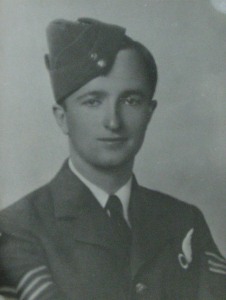Lewis Burpee Jr unveiling the memorial to the crew of AJ-S, killed on the Dams Raid, on 17 May 1943. Pic: Peter van Kaathoven
A memorial to the Dams Raid crew piloted by the Canadian Lewis Burpee was unveiled on Friday near the site where they crashed at Gilze Rijen airfield in the Netherlands. It was attended by a number of local dignitaries and representatives of the RAF, as well as members of the families of Lewis Burpee himself and of his bomb aimer, James Arthur. The BBMF Lancaster PA474 flew over the memorial before landing at the airfield as part of its goodwill tour of the Netherlands.
Burpee was a Canadian, born in Ottawa on 5 March 1918. He had two other Canadians in his crew, rear gunner Gordon Brady from Ponoka, Alberta, and bomb aimer James Arthur from Toronto. Arthur had only joined Burpee’s crew in his previous squadron in March 1943, and had flown on just one operation with his skipper. He was one of the four children of the Rev Alfred and Dora Arthur. His father was an Anglican priest, with a parish in the Toronto suburbs.
The memorial is made up of a large piece of crankshaft from one of the crashed Lancaster’s engines. It has seven pistons, once for each of the AJ-S crew, and is faced with an engraved plaque. It was unveiled on Friday by Burpee’s son, also called Lewis Burpee, who was born on Christmas Eve 1943, seven months after his father’s death.
After the unveiling this group gathered near PA474, seen in the background. Above, left to right: Sander van der Hall, organiser of the memorial appeal; Maureen Burpee; Lewis Burpee Jr; Rev Dom Luke Bell, nephew of James Arthur; Sqn Ldr Andy Millikin, OC BBMF; Air Cdre Chris Lorraine, retired RAF officer; Jonathan Bell and Julian Bell, nephews of James Arthur. Pic: Peter van Kaathoven
More details on the memorial’s Facebook page.




 Further information about James Arthur and the other 132 men who flew on the Dams Raid can be found in my book
Further information about James Arthur and the other 132 men who flew on the Dams Raid can be found in my book